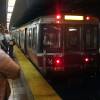West Roxbury's Jerry Boyd said he's lucky he can work from home. As a wheelchair user who has cerebral palsy, the Orange Line shutdown would have made getting to his job as a claims processor near North Station difficult.
But he's still a regular Orange Line user who's navigated the monthlong shutdown to get to appointments, family events or dates with his girlfriend who lives in Roslindale. And overall, he gives the MBTA poor grades for accessibility during the shutdown.
“I do think the T is taking accessibility more seriously,” he said. “But it’s a long, long way to go.”
During the shutdown, Orange Line trains were replaced by shuttle buses, which are technically compliant with the Americans with Disabilities Act. Most of the shuttles are high-floor buses with lifts in the back. The MBTA also provided free ADA-accessible vans along the route for anyone who requested one. The city even overhauled some sidewalks around stops to be more accessible.
GBH News rode along with Boyd and others to better understand the challenges of being in a wheelchair and navigating the shutdown. Here are their stories.
WATCH: Jerry Boyd's trip on the Orange Line shuttle buses
On a recent September evening, Boyd set out to meet his girlfriend for dinner in Back Bay, allowing a reporter to accompany him. The trip took more than an hour and required him to take the 34 bus to Forest Hills and then an Orange Line shuttle.
The MBTA bus ride was smooth, and Boyd noted that the ramp easily extended onto the sidewalk so he could enter the front of the bus. The operator quickly secured Boyd’s chair in the wheelchair area and Boyd settled in, reading his Kindle during the 19-minute ride.
After he arrived at the Forest Hills station, he easily navigated off the bus, through the station and down the elevator to the bus loading area. An MBTA official asked him if he wanted an accessible van, but he declined because he had had a difficult experience on a van the week before.
He tried to board an Orange Line shuttle bus instead. That didn't work. Boyd got his chair onto the lift, but the operator struggled to fully close it, and the metal parts weren’t cooperating. After about five minutes, and asking Boyd to get on and off the lift, another driver motioned to Boyd that he could try the next bus.
The second attempt worked — with complications. Boyd got on the lift, but he had to navigate into a very small space inside the bus and couldn’t turn around. When the operator tried to close the door, it swung and hit Boyd’s feet.
“I don’t feel that safe sitting like this,” Boyd said.
Time was also ticking by.
“Imagine if someone was trying to get to an appointment — I’m just trying to meet my girlfriend for something social,” he continued. “But if I had tickets to a show, or I was working a night shift, this would delay me.”
There are other challenges, too, including how a shuttle or van can only accommodate one wheelchair at a time.
“If I was with a friend, we couldn’t travel together, and that’s absurd — what other population would stand for that?” he said. “It seems like during this whole thing, we were kind of an afterthought.”
The MBTA acknowledged that the shutdown was a challenge for passengers with disabilities.
“While a lot of work went into the development and successful implementation of the alternative services, the MBTA knows there is always room for improvement,” spokesman Joe Pesaturo said. “Fully engaged with its customers, the MBTA will use the Orange Line shuttle experiences to identify potential improvements for future diversions on the rapid transit system.”
Since mid-August, shuttles have also replaced trains along the Green Line. Don Summerfield, a transportation advocate who lives in Cambridge and sometimes uses a wheelchair, said he tried to get on a shuttle at Science Park a few weeks ago unsuccessfully. He said there were seats blocking the spot where a wheelchair user would sit.
“I was pissed,” he said.
Summerfield says it often feels like “20 steps forward, five steps back” when it comes to accessibility on the T.

Tara Southard, a wheelchair user who lives in Jackson Square, also said the vans have been readily available and easy to use during the shutdown.
“I was pleasantly surprised,” she said. “There was no misinformation on where to go to if you needed help.”
Southard recently attended an event at City Hall using the T. When she asked an MBTA representative at the Government Center stop for an accessible van, one appeared within two minutes. A sturdy ramp emerged from the back of a van, and Southard smoothly maneuvered her chair up the ramp before the driver secured her chair in the back.
The whole process took about a minute, and she was off.
Boyd’s experience with an accessible van wasn’t quite as smooth. After a recent Red Sox game with his family, he went to the Ruggles station where an MBTA representative directed him towards a van. The representative didn’t go all the way to the van with him, and he wasn’t very familiar with the station, so he wasn't sure where he was going.
He had other safety concerns too. “The driver didn’t tie me down properly,” he said.
"I do think the T is taking accessibility more seriously. But it's a long, long way to go."-Jerry Boyd
Normally, Boyd gives the MBTA a “solid B” grade on accessibility. But during the shutdown, he gave the MBTA a “D, or an F.” Boyd praised the MBTA’s office of System-Wide Accessibility for their work and is also a member of the Riders’ Transportation Access Group, which is funded by the MBTA to raise accessibility concerns. Still, not all T stops are accessible.
And despite the challenges, Boyd is still a strong proponent of using public transportation. “Without it, you’re really limited in what you can do, particularly as a person with a disability.”
Produced with assistance from the Public Media Journalists Association Editor Corps funded by the Corporation for Public Broadcasting, a private corporation funded by the American people.








